Almost anywhere you live in the US… there is at least a venomous snake living in your area.
If you’ll ever be bitten by a poisonous snake it’s crucial to identify it so you can receive the anti-venom as quickly as possible. The information in this article can save your life.
Children are at higher risk for death or serious complications due to snake bites because of their smaller body size.
Related: 19 Survival Skills You Should Teach your Children This Summer
Rattlesnake
Rattlesnakes can be found almost everywhere in the United States.
The Eastern Diamondback in considered the most venomous species in North America. Surprisingly, juveniles are considered more dangerous than adults. Most species of rattlesnakes have hemotoxic venom, destroying tissue, degenerating organs and causing coagulopathy (disrupted blood clotting).
Related: Best Natural First Aid: Stops Bleeding In 10 Seconds!
Untreated rattlesnake bites, especially from larger species, are very often fatal. However, antivenin, when applied in time, reduces the death rate to less than 4%.
Identification:
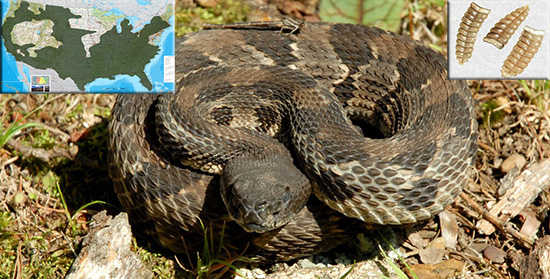
Rattlesnakes can usually be identified by two key characteristics that non-venomous snakes lack. First, they have a broad triangular head, narrow neck and thick body. Secondly, they have a rattle on the end of their tail.
There are a lot of rattlesnake species in the US so it’s not always easy to identify them from a distance.
(Strangely, in this picture you can see a dragonfly siting on this snake.)
How long do you have to get to the hospital before you see God?
It depends on the type of rattlesnake. Most rattlesnakes have hemotoxic blood, meaning it affects localized tissue. Some accounts say that “it feels like being hit with a baseball bat by a pro baseball player, or like getting hit by a bus”. Some are a little nuerotoxic and that would affect breathing and your heart. Nuerotoxic venom hurts worse. Hemotoxic venom, depending on where you are bit, could take hours to kill you if not treated with antivenom. Nuerotoxic venom would kill you much faster. The farther away the bite is from your vital organs, the more time you have potentially. Consider that you have two hours max to seek medical attention. Immobilize the wound, keeping it below heart level. Do not apply a tourniquet, cut or suction the wound, and do not apply ice. If it is necessary to walk, do so slowly, and rest frequently.
Copperhead
The copperheads vary in color from reddish to golden tan. The colored bands on their body are typically hourglass-shaped. Most adults are 18–36 inches long. They are not usually aggressive, but will often freeze when frightened. Workers are more likely to be bitten when they unknowingly step on or near a copperhead.
Though the copperhead bite is rarely lethal (only 3 confirmed deaths in the last 120 years) they account for more bites than any other venomous snake in the country (about 4,000 annually, roughly half of all venomous snakebites).
Identification:
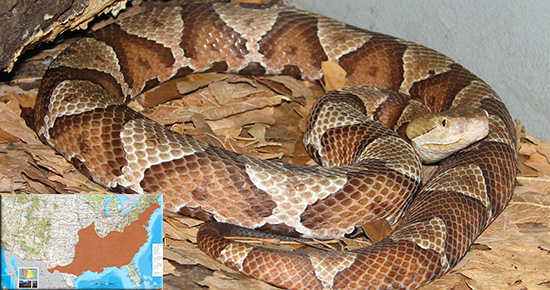
The copperhead is probably one of the most commonly misidentified snakes in the US.
Copperhead has a thick, stout body. Looking at this picture you can see how the snake is thick.
Copperheads are typically brown or orange in color, the shade of dead leaves. This coloration and pattern helps them to blend in with the forest floor. The pattern is comprised of wide, irregular bands that that are darker than the background color of the snake. (Source)
The head is always heart-shaped. (common for venomous snakes)
How long would it take for Copperhead venom to kill you?
The bite is extremely painful and will require minor medical treatment. There are often long term problems to the extremity that is bitten.
A person that has been bitten 3 times by Copperheads:
“I personally have been bitten 3 times by copperheads in my collection & have gotten REALLY uncomfortable & had a fair degree of localized tissue damage, but have not developed gangrene or had any really serious complications. (…) the use of anti-venom serum carries a real danger to the bite victim of a possible severe allergic reaction that could kill the patient while the bite usually won’t.”
Cottonmouth
You can bump into them in wetland areas, rivers or lakes. The Cottonmouth (or water moccasin) is North America’s only venomous water snake.
Identification:
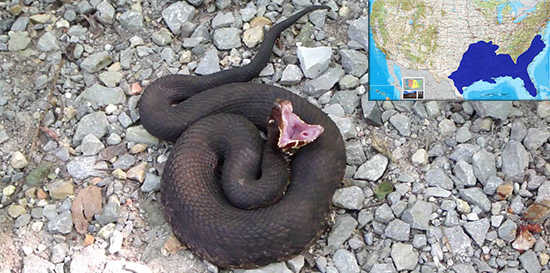
Water moccasins have dark stripes by each nostril and pale snouts.
Nonvenomous water snakes have round pupils, whereas cottonmouths have vertical, catlike pupils. Cottonmouths also have a triangular head, and nonvenomous snakes have a more slender, elliptical head shape.
The adult snake’s skin is dark tan, brown, or nearly black, with vague black or dark brown crossbands.
How long would it take for Cottonmouth venom to kill you?
One bite doesn’t kill you directly.
But if you are in the water you’ll become very fast incapacitated enough to drown. There was a case a couple of years ago in North Carolina (Source)
Also … if you are bitten multiple times it can be fatal. Consider that you have one hour max to seek medical attention.
Coral Snakes
The coral snake is the most toxic of the four on this list. And, outrageously, there is NO commercially available anti-venom for coral snake bites in the U.S.
Identification:
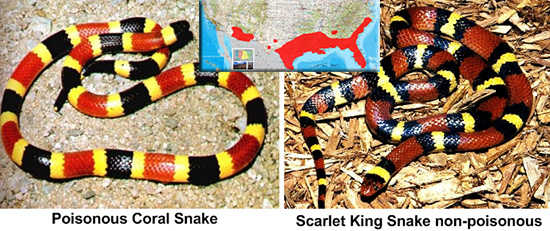
Coral Snake has one very similar fellow: the King Snake. As long as you know this difference it’s extremely easy to identify.
The Coral snake colors are always red, then yellow (thinner band), then black.
Here’s how to make this easy to remember:
“Red touch yellow, kill a fellow.” (Deadly Coral snake)
“Red touch black, friend of Jack.” (Harmless King snake)
How long would it take for Coral Snake venom to kill you?
The snake’s neurotoxic venom causes rapid paralysis and respiratory failure in its prey; however, according to the National Institutes of Health, it can take many hours for symptoms to appear in humans. The first symptoms can be slurred speech, double vision, and muscular paralysis. (Source) Consider that you have one hour max to seek medical attention.
General Safety
- Be careful where you step
- Save this number: Snake Bite Poison Line – 1-800-222-1222 available 24/7
- Try to avoid entering tall grass especially near rivers and lakes – when possible
- Be careful when climbing on rocks or piles of wood where a snake may be hiding
- Wear thick boots and long pants when working outdoors
- Wear leather gloves when handling brush and debris
If you’ve been bitten:
- Try to remember the color and shape of the snake
- Of course, dial 911 or get to the nearest hospital
- Remove any rings, watches, tight clothing and anything else from the bitten limb, because the swelling will make it a lot bigger soon
- Drink some water and take some calories if you have any.
A list of don’ts
- Don’t pick up the snake or try to trap it (as some folks did)
- Don’t apply a tourniquet, don’t slash the wound with a knife (above or below)
- Don’t suck out the venom
- Don’t apply ice or immerse the wound in water
- Don’t drink alcohol as a painkiller and don’t drink caffeinated beverages
- All Snake Bite Kits are dangerous and should not be used (Jordan Benjamin – herpetologist specialized in venomous snakes). This was also confirmed by the Snake Bite Poison Line
- Do not wait for symptoms to appear if bitten
You may also like:
 Preparing for the Mega-Drought: The Water Generator (Video)
Preparing for the Mega-Drought: The Water Generator (Video)
An Insanely Effective Way to Build a 5 Year Food Stockpile (Video)

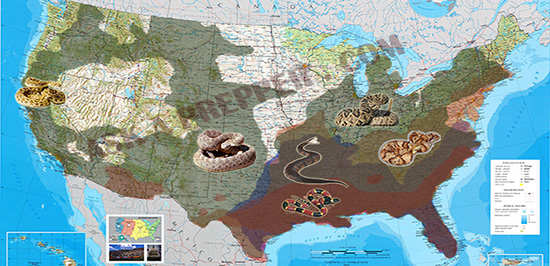













According to the Michigan DNR, the ONLY venomous snake in Michigan is the Eastern Massasauga (Sistrurus catenatus catenatus). The Massasauga is a “Protected” species. My grandfather, who is almost 87, claims to have only ever seen one. I’ve never seen one in my 42 years.
Michigan DNR page about the Massasauga, titled, “Michigan’s Only Venomous Snake” (includes a 60 second video about the snake): http://www.michigan.gov/dnr/0,1607,7-153-10370_12145_12201-32995–,00.html
US Fish and Wildlife Service page about the Massasauga: http://www.fws.gov/Midwest/endangered/reptiles/eama/index.html/croada.htm
I live in So CA and was in a Pets-R-Us store when a woman walked in and wanted to buy some medicine for a snake bite. She said a rattlesnake bit her son when they were turning over rocks. We were amazed at the stupidity of this woman. The cashier at the store picked up the phone and dialed 911 and an ambulance came and took that poor boy to the hospital.
That’s not “stupidity.” It’s “ignorance.” Nothing to make fun of her about. Most people never encounter snakes and don’t know about them. There are probably lots of dangerous things YOU are ignorant about, and surely you’d hope no one would look down on you for not knowing. For example, your nickname advertises that you mate with pets; that’s a dangerous act, but I’m not going to make fun of you for it, because you’re probably not aware that it’s unhealthy. No one human being can know everything.
Are you being serious? Lol wow, the only stupid person here is you.
Arizona has 3 different king snakes, black is the dominant one, but red kings are here, and banded. The banded looks like an Asian krait, and when I first saw one, thought that is was some weirdo’s pet that got out. niio